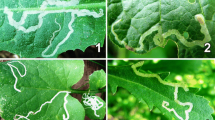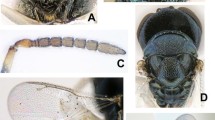Abstract
Three species of lepidopterous larvae were collected fromAmaranthus hybridus L. growing in field corn during 1975 and 1976 at Hastings, Florida.Spodoptera exigua (Hubner) was the predominant species in May.Spodoptera eridania (Cramer) was predominant in June andHerpetogramma bipunctalis (F.) in July and August.
Nine native species of parasites, representing theBraconidae, Eulophidae, Ichneumonidae andTachinidae, emerged from these larvae.Meteorus autographae Muesebeck emerged from bothS. exigua andS. eridania. TheTachinidae, Winthemia rufopicta (Bigot),Eucelatori rubentis (Coquillett) andLespensia sp., emerged from mixtures ofS. exigua andS. eridania. Apanteles marginiventris (Cresson),Temelucha sp., andChelonus texanus Cresson emerged from bothS. exigua andH. bipunctalis larvae, andEuplectrus platyhypenae Howard andOphion sp. emerged fromS. eridania.
All the species of parasites from the lepidopterous larvae that feed onAmaranthus hybridus are also reported as parasites ofS. frugiperda, a serious pest of corn. Therefore these larvae onA. hybridus may be a source of the parasites found attackingS. frugiperda.
Résumé
Trois espèces de chenilles ont été récoltées sur la mauvaise herbe,Amaranthus hybridus L. poussant dans des cultures de maïs à Hastings, Floride, en 1975 et 1976.Spodoptera exigua (Hubner) était l'espèce la plus fréquente en mai,Spodoptera eridania (Cramer) en juin etHerpetogramma bipunctalis (F.) en juillet et en août. Neuf espèces de parasites indigènes appartenant auxBraconidae, Eulophidae, Ichneumonidae etTachinidae furent obtenues de ces chenilles.Meteorus autographae Muesebeck provenait à la fois deS. exigua etS. eridania. Apanteles marginiventris (Cresson),Temelucha sp. etChelonus texanus Cresson étaient obtenus à la fois des chenilles deS. exigua et deH. bipunctalis, etEuplectrus plathyhypenae Howard etOphion sp. sortaient deS. eridania.
Toutes les espèces de parasites issues de ces chenilles vivant surAmaranthus hybridus sont aussi connues comme parasites deS. frugiperda, ravageur important du maïs. Aussi, ces larves surA. hybridus peuvent être la source de parasites susceptibles de s'attaquer àS. frugiperda.
Similar content being viewed by others
References
Tingle, F. C. &Mitchell, E. R. — 1977. Seasonal populations of armyworms and loopers at Hastings, Florida. —Fla. Entomol., 60, 115–122.
Wene, G. P. &Sheets, L. W. — 1965. Migration of beet armyworm larvae. —J. Econ. Entomol., 58, 168–169.
Author information
Authors and Affiliations
Rights and permissions
About this article
Cite this article
Tingle, F.C., Ashley, T.R. & Mitchell, E.R. Parasites ofSpodoptera exigua, S. eridania [Lep.: Noctuidae] andHerpetogramma bipunctalis [Lep.: Pyralidae] collected fromAmaranthus hybridus in field corn. Entomophaga 23, 343–347 (1978). https://doi.org/10.1007/BF02373051
Published:
Issue Date:
DOI: https://doi.org/10.1007/BF02373051




